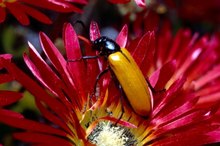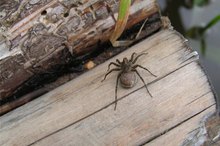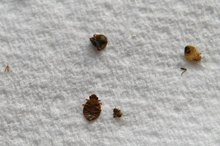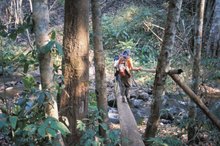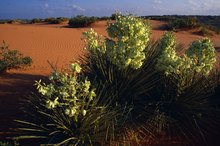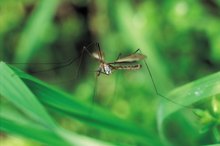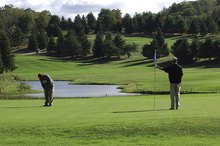Common Spiders in Nevada
Nevada's hot climate makes it an ideal state for certain spiders to live. Many of the spiders that live in Nevada pose no threat to humans, but there are still a few with bites that can be unpleasant. Knowing what kind of spiders reside in your area can help you determine whether a spider that you encounter is potentially dangerous.
Wolf Spider
The wolf spider has a venomous bite 1. The bite is not fatal but can be very painful. The wolf spider is very common in Nevada. It is identified by its hairy body. Wolf spiders resemble a smaller version of the tarantula and can get up to about five inches in length. They are a brown camouflage color that blends into desert environments. Wolf spiders tend to be nocturnal but can be active in both the day and night time. Wolf spiders will attack if they feel threatened.
- The wolf spider has a venomous bite 1.
- Wolf spiders will attack if they feel threatened.
Jumping Spider
Poisonous Wood Spiders
Learn More
Jumping spiders are also very common throughout Nevada. This spider is not dangerous but will usually attack if it feels threatened. The spider is called the jumping spider because it will leap large distances at times. The jumping spiders that reside in Nevada tend to be brown or black and no more than a couple of inches in length.
- Jumping spiders are also very common throughout Nevada.
- The spider is called the jumping spider because it will leap large distances at times.
Araneus gemma
Araneus gemma, commonly called the cat-faced spider, is also common throughout Nevada. This spider is not dangerous to humans. They are usually no more than half an inch in length. It weaves an orb-like web. They are typically orange or brown.
- Araneus gemma, commonly called the cat-faced spider, is also common throughout Nevada.
- They are usually no more than half an inch in length.
Funnel-Weaving Spider
Which Insect Bites Cause Blisters?
Learn More
The funnel-weaving spider is commonly found in houses in Nevada. This spider is shy and not dangerous to humans. They look very similar to the wolf spider, though one defining characteristic is that these spiders build webs, unlike the wolf spider. Most funnel weavers are brown and build their nests in lawns, usually protected by rocks or webs. These spiders will only attacked when provoked.
- The funnel-weaving spider is commonly found in houses in Nevada.
- They look very similar to the wolf spider, though one defining characteristic is that these spiders build webs, unlike the wolf spider.
Giant Crab Spider
This is a huge spider and very common in Nevada. They have a leg span of about two inches. These look rather scary but are not dangerous to humans but their bite can be quite painful. These spiders are usually brown. They are typically found under rocks and dark dwellings. The giant crab spider is nocturnal 1.
- This is a huge spider and very common in Nevada.
Related Articles
References
- Orkin: Wolf Spider Charactersitics
- Cedars Sinai Medical Center. Brown Recluse and Black Widow Spider Bites in Children.
- Sotelo-cruz N, Gómez-rivera N. [Neurotoxic manifestations of black widow spider envenomation in paediatric patients]. Neurologia. 2016;31(4):215-22. doi:10.1016/j.nrl.2015.05.007
- Williams M, Nappe TM. Black Widow Spider Toxicity. StatPearls Publishing. Updated March 8, 2019.
- Stoecker WV, Vetter RS, Dyer JA. NOT RECLUSE-A Mnemonic Device to Avoid False Diagnoses of Brown Recluse Spider Bites. JAMA Dermatol. 2017;153(5):377-378. doi:10.1001/jamadermatol.2016.5665
- Vetter RS. The distribution of brown recluse spiders in the southeastern quadrant of the United States in relation to loxoscelism diagnoses. South Med J. 2009;102(5):518-22. doi:10.1097/SMJ.0b013e3181a0abb3
- Illinois Department of Public Health. Brown Recluse and Black Widow Spiders.
- Rahmani F, Banan Khojasteh SM, et al. Poisonous Spiders: Bites, Symptoms, and Treatment; an Educational Review. Emerg (Tehran). 2014;2(2):54-8.
- Gaver-wainwright MM, Zack RS, Foradori MJ, Lavine LC. Misdiagnosis of spider bites: bacterial associates, mechanical pathogen transfer, and hemolytic potential of venom from the hobo spider, Tegenaria agrestis (Araneae: Agelenidae). J Med Entomol. 2011;48(2):382-8. doi:10.1603/ME09224
- Livshits Z, Bernstein B, Sorkin LN, Smith SW, Hoffman RS. Wolf spider envenomation. Wilderness Environ Med. 2012;23(1):49-50. doi:10.1016/j.wem.2011.11.010
- Meires J, Louden B. Bite of the Brown Recluse Spider. Clinical Review. 2010(12):14-17.
- Pagac BB, Reiland RW, Bolesh DT, Swanson DL. Skin lesions in barracks: consider community-acquired methicillin-resistant Staphylococcus aureus infection instead of spider bites. Mil Med. 2006;171(9):830-2. doi:10.7205/milmed.171.9.830
- Mikals K, Beakes D, Banks TA. Stinging the Conscience: A Case of Severe Hymenoptera Anaphylaxis and the Need for Provider Awareness. Mil Med. 2016;181(10):e1400-e1403. doi:10.7205/MILMED-D-15-00536
- Gaver-Wainwright MM, Zack RS, Foradori MJ, Lavine LC. Misdiagnosis of spider bites: bacterial associates, mechanical pathogen transfer, and hemolytic potential of venom from the hobo spider, Tegenaria agrestis (Araneae: Agelenidae). J Med Entomol. 2011 Mar;48(2):382-8.
- Isbister GK, Framenau VW. Australian wolf spider bites (Lycosidae): clinical effects and influence of species on bite circumstances. J Toxicol Clin Toxicol. 2004;42(2):153-61.
- Livshits, Z., Bernstein, B., Sorkin, L., Smith, S., & Hoffman, R. (2012). Wolf Spider Envenomation. Wilderness & Environmental Medicine, 23(1), 49-50. doi:10.1016/j.wem.2011.11.010
- Pagac BB, Reiland RW, Bolesh DT, Swanson DL. Skin lesions in barracks: consider community-acquired methicillin-resistant Staphylococcus aureus infection instead of spider bites. Mil Med. 2006 Sep;171(9):830-2.
- Payne, K., Schilli, K., Meier, K., Rader, R., Dyer, J., & Mold, J. et al. (2014). Extreme Pain From Brown Recluse Spider Bites. JAMA Dermatology, 150(11), 1205. doi:10.1001/jamadermatol.2014.605
- Robinson, J., Kennedy, V., Doss, Y., Bastarache, L., Denny, J., & Warner, J. (2017). Defining the complex phenotype of severe systemic loxoscelism using a large electronic health record cohort. PLOS ONE, 12(4), e0174941. doi:10.1371/journal.pone.0174941
- Stoecker, W., Vetter, R., & Dyer, J. (2017). NOT RECLUSE—A Mnemonic Device to Avoid False Diagnoses of Brown Recluse Spider Bites. JAMA Dermatology. doi:10.1001/jamadermatol.2016.5665
Writer Bio
Arman Khodaei has been writing professionally since 2004, when his short memoir was published in the "Nota Bene" anthology, for which he received the Reynolds Scholarship. He serves on an Autism Committee for the California State Senate and has been involved in the autistic community for more than five years. He received his Associate of Arts from Lakeland Community College.

